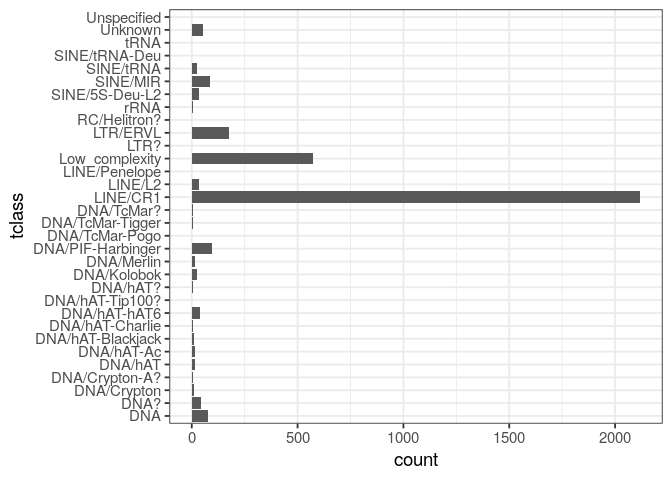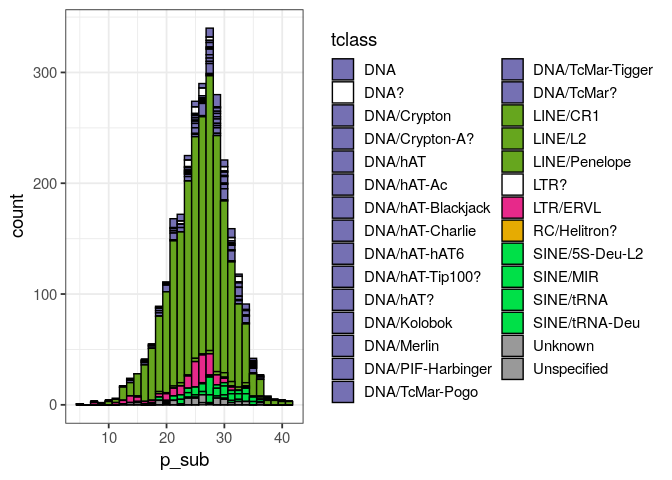Read and analyse RepeatMasker output in R.
Very early in development!
library(devtools)
install_github("dwinter/repeatR")The package comes with a small example dataset, including the repeats from one scaffold in the kākāpō assembly. We can read this file in memory using read_rm
library(repeatR)
#> Loading required package: dplyr
#>
#> Attaching package: 'dplyr'
#> The following objects are masked from 'package:stats':
#>
#> filter, lag
#> The following objects are masked from 'package:base':
#>
#> intersect, setdiff, setequal, union
#> Loading required package: stringr
#> Loading required package: data.table
#>
#> Attaching package: 'data.table'
#> The following objects are masked from 'package:dplyr':
#>
#> between, first, last
# create a file path relative to the installed package, this step is not
# necessary for normal usage
rm_file <- system.file("extdata", "kakapo.out", package="repeatR")
kakapo <- read_rm(rm_file)
kakapo
#> RepeatMasker output with 3496 entries for 3382 unique repeat sequences
#> score p_sub p_del p_ins qname qstart qend qextend complement
#> 1 13 22.0 0.0 4.5 NC_044289.2 774 819 16475341 +
#> 2 993 25.1 5.5 0.0 NC_044289.2 2297 2567 16473593 C
#> 3 751 30.3 1.5 4.2 NC_044289.2 3418 3758 16472402 C
#> tname tclass tstart tend textend ID ali_type
#> 1 G-rich Low_complexity 1 44 0 376812 primary
#> 2 TguLTR5d LTR/ERVL 8 293 302 376814 primary
#> 3 CR1-Y2_Aves LINE/CR1 3007 3338 1 376815 primaryAs you can see, the function reads tdata and returns a data.frame with the alignment information from RepeatMasker.We can now quickly look at the composition of the repeats alignments on this scaffold:
library(ggplot2)
ggplot(kakapo, aes(tclass)) +
geom_bar() +
coord_flip() +
theme_bw(base_size=14) It is important to note, however, that the alignment between a reference genome and a given repeat element might be broken up over multiple rows in RepeatMakser output. This occurs when elements are nested within each other (a pattern that is very common for some elements in some species). repeatR provides a the function summarise_rm_ID to produce a new table with one row per unique element in the genome.
kakapo_aggregated <- summarise_rm_ID(kakapo)
head(kakapo_aggregated)
#> ID score p_sub p_del p_ins qname qstart qend qlen qextend
#> 1 376812 13 22.0 0.0 4.5 NC_044289.2 774 819 46 16475341
#> 2 376814 993 25.1 5.5 0.0 NC_044289.2 2297 2567 271 16473593
#> 3 376815 751 30.3 1.5 4.2 NC_044289.2 3418 3758 341 16472402
#> 4 376818 938 30.9 2.0 2.5 NC_044289.2 6657 7035 379 16469125
#> 5 376817 397 36.4 7.9 0.4 NC_044289.2 7038 7291 254 16468869
#> 6 376820 439 24.8 0.0 0.0 NC_044289.2 11629 11732 104 16464428
#> n_aligned_segments complement tname tclass tstart tend tlen
#> 1 1 + G-rich Low_complexity 1 44 44
#> 2 1 C TguLTR5d LTR/ERVL 8 293 286
#> 3 1 C CR1-Y2_Aves LINE/CR1 3007 3338 332
#> 4 1 + CR1-Y2_Aves LINE/CR1 3008 3331 324
#> 5 1 C CR1-Y2_Aves LINE/CR1 800 1072 273
#> 6 1 C TguLTR5d LTR/ERVL 492 595 104
#> ali_type
#> 1 primary
#> 2 primary
#> 3 primary
#> 4 primary
#> 5 primary
#> 6 primaryWith this data, we can start to analyse the total amount of the scaffold covered by elements of different classes
ggplot(kakapo_aggregated, aes(qlen, tclass)) +
geom_col() +
theme_bw(base_size=14) +
scale_x_continuous(labels=Mb_lab) Quite often, you will want to remove some fo the sequences that are included in the output file. For instance, simple repeats and low complexity regions. The function filter_by_tclass will remove thise sequences along with functional RNAs and ARTEFACT sequences.
kakapo_just_TEs <- filter_by_tclass(kakapo_aggregated)
table(kakapo_just_TEs$tclass)
#>
#> DNA DNA? DNA/Crypton DNA/Crypton-A?
#> 74 43 13 6
#> DNA/hAT DNA/hAT-Ac DNA/hAT-Blackjack DNA/hAT-Charlie
#> 15 14 10 3
#> DNA/hAT-hAT6 DNA/hAT-Tip100? DNA/hAT? DNA/Kolobok
#> 38 1 4 26
#> DNA/Merlin DNA/PIF-Harbinger DNA/TcMar-Pogo DNA/TcMar-Tigger
#> 15 96 2 8
#> DNA/TcMar? LINE/CR1 LINE/L2 LINE/Penelope
#> 4 2049 35 3
#> LTR? LTR/ERVL RC/Helitron? SINE/5S-Deu-L2
#> 3 140 1 32
#> SINE/MIR SINE/tRNA SINE/tRNA-Deu Unknown
#> 86 27 2 55
#> Unspecified
#> 3Or the distrbution of the p_sub statistic (the proportion of bases that different from the consensus element). The function make_TE_pallete includes a pre-defined pallete for the tclass column.
ggplot(kakapo_just_TEs, aes(p_sub, fill=tclass)) +
geom_histogram(colour="black") +
scale_fill_manual(values=make_TE_pallete(kakapo_aggregated)) +
theme_bw(base_size=14)
#> `stat_bin()` using `bins = 30`. Pick better value with `binwidth`.

